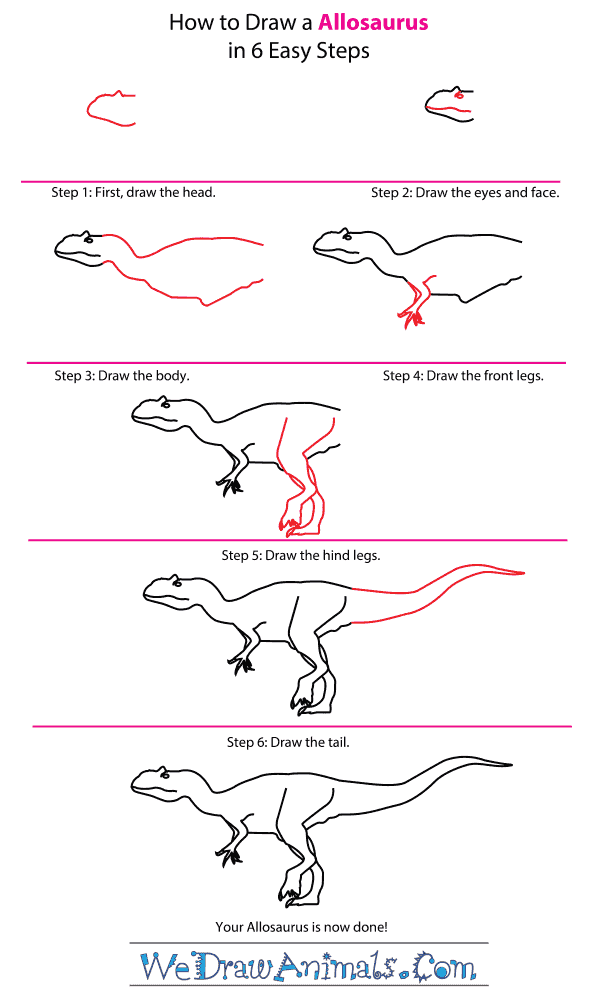In this quick tutorial you'll learn how to draw an Allosaurus in 6 easy steps - great for kids and novice artists.
The images above represent how your finished drawing is going to look and the steps involved.
Below are the individual steps - you can click on each one for a High Resolution printable PDF version.
At the bottom you can read some interesting facts about the Allosaurus.
Make sure you also check out any of the hundreds of drawing tutorials grouped by category.
How to Draw an Allosaurus - Step-by-Step Tutorial
Step 1: First, draw the head. For this, imagine a peanut shape, with most of the back missing where the neck will start, and with a small bump towards the front. This is the horn and ridge that Allosaurs had above their eyes.
Step 2: Draw the eyes and face: a small circle below the horn for the eyes and a line to show the mouth.
Step 3: Draw the body, starting with a strong but short neck that curves downward slightly from the back of the head and leads into a wider shape that becomes the body. Draw a humped line on top and slightly straighter one on the bottom that meet closer near the tail.
Step 4: Draw the front legs, which were larger than a lot of other therapods’ like the T-Rex’s. Even more distinct were the large, sharp claws on the Allosaurus’s three fingers.
Step 5: Draw the hind legs, which are very long, with large thighs and narrow lower legs. You may want to break it down into a series of curved lines, bending for the thighs, knees, shins, and ankles. Try drawing one raised up as if the Allosaurus were running. The feet are large and flat.
Step 6: Draw the tail, thick and curving slightly for balance behind the dinosaur but ending in a narrow point like a whip.
Interesting Facts about the ALLOSAURUS
The Allosaurus is a member of the dinosaur group and the scientific term for them is A. fragilis. Their Greek name “allo-saurus” means “different-lizard” in English. The Latin word “fragilis” means “fragile” in English, because this animal possessed delicate framework in its skeleton. Despite this disadvantage, the large two-legged predators were therefore not too heavy for running quickly. Another aspect that contributed to its lightweight body was small arms, but the tail was very large for maintaining balance.
Did you know?
- The animal was first documented in 1877.
- They could grow to more than 40 feet long.
- The age was up to about 28 years.
- They could weigh almost 9,000 pounds.
- The mouth could generate about 180 pounds of force.
small but interesting detail is the short horn above each eye, which may have been used to protect their sight. Though this animal had a large head, it possessed very little muscle. It therefore was incapable of biting sufficiently, and it was actually less than the force of an alligator. They killed their prey by opening very wide and stabbing other animals with its upper teeth. These creatures lived mainly in the northwest North America, but also southwest Europe and east-central Africa.







